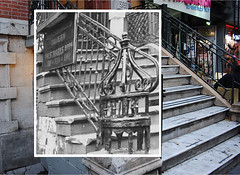This post was reported by NYU Journalism’s Rachel Slaff, Todd Olmstead and Nasry Esmat. It was written by Ms. Slaff.
Yoga studios. Frozen yogurt stores. Tattoo parlors. Knock-off Ray-Bans, colorful socks and bubble tea – all for sale. Tourists swarm by pizza shops; college students flick cigarette butts onto the street. It’s loud, it’s crowded. It’s every possible cliche of the East Village, packed onto a block. This is St. Marks Place.
But fast food and neon lights haven’t always epitomized this street. Building No. 20, between Second and Third Avenues, has seen St. Marks Place change drastically over more than two centuries. This rowhouse traces its lineage back to wealthy descendants of the Stuyvesants, yet it also watched Warhol cavort through the Village. It witnessed the aftershock of a horrific peacetime maritime disaster. It has been home to soldiers and storeowners and has housed a dress shop, a carpentry workshop and a record store. No. 20 is a historical hold-out, an architectural remnant of times long forgotten in the East Village.
The metal plaque from the New York Community Trust that is affixed to No. 20’s facade notes that the address has landmark status for its late-Federal style architecture. But the ornament is not large or flashy enough to draw much attention – it is as if the building wants to be left alone. The plain signs of the businesses on its first two floors are a muted counterpoint to the sensory overload that the rest of the block exudes. The building’s iron railing is decrepit, its brick facade unremarkable, and yet, the limestone molding on the door hints at a meaningful history.
When it was conceived in the 1830’s by developer Thomas E. Davis, 20 St. Marks was part of one of the first housing developments in New York. The house was sold on Dec. 19, 1831 to Daniel LeRoy, the husband of Susan Fish. The building’s elegant architecture was not the only reason that No. 20 acquired historic status later in life. Susan Fish’s mother, Elizabeth Stuyvesant Fish, was a descendant of Peter Stuyvesant, the last governor of New Netherland in the late seventeenth century. The walls, if they could talk, might tell tales of of New York’s oldest and richest families in the 1830’s.
When 20 St. Marks Place received its landmark nomination, James E. Dibble, a specialist for the Landmarks Preservation Commission, wrote, “It is a tangible reminder of one of the last neighborhoods of old New York where the founding families resided side-by-side in an exclusive community.”
In 1834, the LeRoy family conveyed the property to Samuel Packwood. Both Daniel LeRoy and Samuel Packwood listed “none” as their occupations on the 1850 U.S. Federal Census.
In 1867, John W. Miller became the next listed resident, maintaining the property throughout the 1870s as the New York Athletic Club Gymnasium, a space made available for community meetings and recreation in those years.
By the late 1800’s, the building’s lineage becomes muddled. Ownership and leasing records are unclear. One identifiable resident from this gray era was Joseph Stollwerk, a German immigrant who told census workers he a confectioner. Whether he was related to the Stollwerck Brothers of German candy company fame is unclear.
On Oct. 28, 1902, the executors of a John W. Muller leased 20 St. Marks to Martha Moller. Less than two years later, on June 15, 1904, a steamboat, The General Slocum, set out on a picnic hosted by St. Mark’s Evangelical Lutheran Church on East Sixth Street. Carrying mostly women and children who lived near the church, the ship caught fire on the East River. It was the greatest loss of life in New York until the World Trade Towers fell. Mrs. Moller was among the1,021 lives that were lost.
After the disaster, explained Andrew Berman, executive director of the Greenwich Village Society for Historic Preservation, “You saw the decline of the German population in what is now known as the East Village.”In the early twentieth century, Jews and other Eastern European ethnic groups moved into the neighborhood, followed by a sizable migration of Puerto Ricans in the middle of the century.
As 20 St. Marks aged, its surroundings continued to shift. Beginning in the 1920’s, the row of buildings across the street evolved. From what was the Polish National Home, they became The Dom nightclub and then the dance club Electric Circus. While Mr. Warhol and the Velvet Underground experimented their way through the 1960’s elsewhere on the block, 20 St. Marks Place remained relatively quiet.
A boutique named Gussie and Becky occupied the main floor of the building during that decade. By 1971, No. 20 earned its landmark status. A nomination form for the National Register of Historic Places in 1984 reads, “The Daniel LeRoy House is a rare and intact surviving example of the late federal style mansions which once lined St. Marks Place.” In the 1970’s, the building housed the Lady Carpenter Institute of Building and Home Improvement, designed to teach women carpentry skills. Sounds was the name of a a music store that moved into the building in 1979, when the neighborhood was home to CBGB and the punk rock scene. Today, however, the windows look out on passing tourists and students more often than on artists and rock stars.
Join the conversation: Have any memories of 20 St. Marks Place? Share them.






